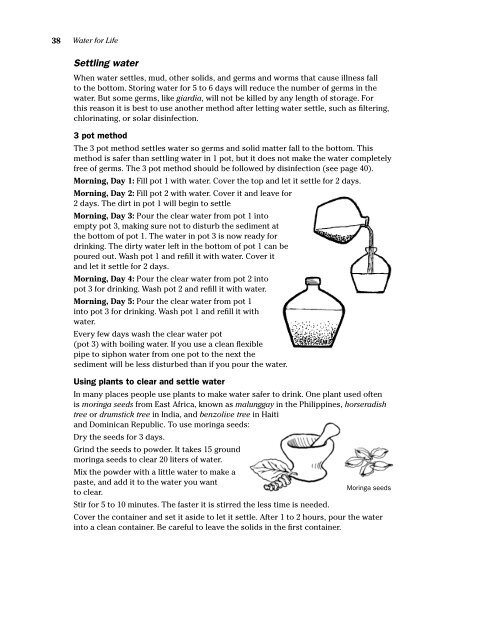Community water security - UN-Water
Community water security - UN-Water
Community water security - UN-Water
You also want an ePaper? Increase the reach of your titles
YUMPU automatically turns print PDFs into web optimized ePapers that Google loves.
38<br />
<strong>Water</strong> for Life<br />
Settling <strong>water</strong><br />
When <strong>water</strong> settles, mud, other solids, and germs and worms that cause illness fall<br />
to the bottom. Storing <strong>water</strong> for 5 to 6 days will reduce the number of germs in the<br />
<strong>water</strong>. But some germs, like giardia, will not be killed by any length of storage. For<br />
this reason it is best to use another method after letting <strong>water</strong> settle, such as filtering,<br />
chlorinating, or solar disinfection.<br />
3 pot method<br />
The 3 pot method settles <strong>water</strong> so germs and solid matter fall to the bottom. This<br />
method is safer than settling <strong>water</strong> in 1 pot, but it does not make the <strong>water</strong> completely<br />
free of germs. The 3 pot method should be followed by disinfection (see page 40).<br />
Morning, Day 1: Fill pot 1 with <strong>water</strong>. Cover the top and let it settle for 2 days.<br />
Morning, Day 2: Fill pot 2 with <strong>water</strong>. Cover it and leave for<br />
2 days. The dirt in pot 1 will begin to settle<br />
Morning, Day 3: Pour the clear <strong>water</strong> from pot 1 into<br />
empty pot 3, making sure not to disturb the sediment at<br />
the bottom of pot 1. The <strong>water</strong> in pot 3 is now ready for<br />
drinking. The dirty <strong>water</strong> left in the bottom of pot 1 can be<br />
poured out. Wash pot 1 and refill it with <strong>water</strong>. Cover it<br />
and let it settle for 2 days.<br />
Morning, Day 4: Pour the clear <strong>water</strong> from pot 2 into<br />
pot 3 for drinking. Wash pot 2 and refill it with <strong>water</strong>.<br />
Morning, Day 5: Pour the clear <strong>water</strong> from pot 1<br />
into pot 3 for drinking. Wash pot 1 and refill it with<br />
<strong>water</strong>.<br />
Every few days wash the clear <strong>water</strong> pot<br />
(pot 3) with boiling <strong>water</strong>. If you use a clean flexible<br />
pipe to siphon <strong>water</strong> from one pot to the next the<br />
sediment will be less disturbed than if you pour the <strong>water</strong>.<br />
Using plants to clear and settle <strong>water</strong><br />
In many places people use plants to make <strong>water</strong> safer to drink. One plant used often<br />
is moringa seeds from East Africa, known as malunggay in the Philippines, horseradish<br />
tree or drumstick tree in India, and benzolive tree in Haiti<br />
and Dominican Republic. To use moringa seeds:<br />
Dry the seeds for 3 days.<br />
Grind the seeds to powder. It takes 15 ground<br />
moringa seeds to clear 20 liters of <strong>water</strong>.<br />
Mix the powder with a little <strong>water</strong> to make a<br />
paste, and add it to the <strong>water</strong> you want<br />
to clear.<br />
Stir for 5 to 10 minutes. The faster it is stirred the less time is needed.<br />
Moringa seeds<br />
Cover the container and set it aside to let it settle. After 1 to 2 hours, pour the <strong>water</strong><br />
into a clean container. Be careful to leave the solids in the first container.
















